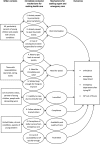'Clinically unnecessary' use of emergency and urgent care: A realist review of patients' decision making
- PMID: 31663219
- PMCID: PMC6978874
- DOI: 10.1111/hex.12995
'Clinically unnecessary' use of emergency and urgent care: A realist review of patients' decision making
Abstract
Background: Demand is labelled 'clinically unnecessary' when patients do not need the levels of clinical care or urgency provided by the service they contact.
Objective: To identify programme theories which seek to explain why patients make use of emergency and urgent care that is subsequently judged as clinically unnecessary.
Design: Realist review.
Methods: Papers from four recent systematic reviews of demand for emergency and urgent care, and an updated search to January 2017. Programme theories developed using Context-Mechanism-Outcome chains identified from 32 qualitative studies and tested by exploring their relationship with existing health behaviour theories and 29 quantitative studies.
Results: Six mechanisms, based on ten interrelated programme theories, explained why patients made clinically unnecessary use of emergency and urgent care: (a) need for risk minimization, for example heightened anxiety due to previous experiences of traumatic events; (b) need for speed, for example caused by need to function normally to attend to responsibilities; (c) need for low treatment-seeking burden, caused by inability to cope due to complex or stressful lives; (d) compliance, because family or health services had advised such action; (e) consumer satisfaction, because emergency departments were perceived to offer the desired tests and expertise when contrasted with primary care; and (f) frustration, where patients had attempted and failed to obtain a general practitioner appointment in the desired timeframe. Multiple mechanisms could operate for an individual.
Conclusions: Rather than only focusing on individuals' behaviour, interventions could include changes to health service configuration and accessibility, and societal changes to increase coping ability.
Keywords: emergency medicine; heath care seeking behaviour; patients; urgent care.
© 2019 The Authors Health Expectations published by John Wiley & Sons Ltd.
Conflict of interest statement
The authors declare that they have no conflicts of interest.



